Electric Vehicle Deployment and Integration in the Saudi Electric Power System
Abstract
:1. Introduction
- Creating another peak demand to the 24-h load curve.
- Adding more load on the main peak demand.
- Increasing the total electricity demand.
- Study the impact of EVs charging on the operation of the electric grid in the Kingdom.
- Understand the behavior of the daily load curve after integrating EVs.
- Investigate the impact of daily EVs charging on the load curve patterns.
2. Developments in EVs Technology
3. The Saudi Electrical Energy System
4. Modeling of EVs Demand
- standard deviation;
- mean.
- Number of days since last charge of a battery;
- Travelled distance of an electric vehicle I;
- Maximum range that can an electric vehicle i travel.
- Charging demand according to the type of charge;
- K Subscript refers to the serial of specific time sample;
- Time at sample k;
- Time at sample k − 1.
- Time;
- The time at which the vehicle is plugged to the system;
- Final time for a battery to be fully charged;
- Unit step function to express the total charging time required to charge the electric vehicle.
5. Conclusions
Funding
Institutional Review Board Statement
Informed Consent Statement
Data Availability Statement
Acknowledgments
Conflicts of Interest
References
- King Abdullah Petroleum Studies and Research Center. Electric Power Generation Capacity and Number of Subscribers. Available online: https://datasource.kapsarc.org/explore/dataset/electric-power-generation-capacity-and-number-of-subscribers/information/?disjunctive.indicators (accessed on 25 May 2020).
- Saudi Arabia Report. 2013. Available online: https://www.eia.gov/international/analysis/country/SAU (accessed on 21 February 2021).
- “Saudi Vision 2023.” Vision 2030. Saudi Arabia. Available online: http://vision2030.gov.sa/en (accessed on 23 May 2020).
- Elshurafa, A.M.; Peerbocus, N. Electric vehicle deployment and carbon emissions in Saudi Arabia: A power system perspective. Electr. J. 2020, 33, 106774. [Google Scholar] [CrossRef]
- Hausfather, Z. Factcheck: How Electric Vehicles Help to Tackle Climate Change. Carbon Brief, 14 May 2019; Volume 13. Available online: https://www.eco-business.com/news/factcheck-how-electric-vehicles-help-to-tackle-climate-change/ (accessed on 13 March 2022).
- Bellocchi, S.; Gambini, M.; Manno, M.; Stilo, T.; Vellini, M. Positive interactions between electric vehicles and renewable energy sources in CO2-reduced energy scenarios: The Italian case. Energy 2018, 161, 172–182. [Google Scholar] [CrossRef]
- Vision2030. National Transformation Program Delivery Plan 2018–2020. Available online: https://www.vision2030.gov.sa/v2030/vrps/ntp/ (accessed on 18 February 2021).
- Wogan, D.; Carey, E.; Cooke, D. Policy Pathways to Meet Saudi Arabia’s Contribution to the Paris Agreement; Climate Change Governance: Washington, DC, USA, 2019. [Google Scholar]
- Office of Energy Efficiency and Renewable Energy. Electric Vehicle Benefits. Available online: https://www.energy.gov/eere/about-office-energy-efficiency-and-renewable-energy (accessed on 3 June 2020).
- Giráldez, J.; Roche, R.; Suryanarayanan, S.; Zimmerle, D. A Linear Programming Methodology to Quantify the Impact of PHEVs with V2G Capabilities on Distribution Systems. In Proceedings of the 2013 IEEE Green Technologies Conference (GreenTech), Denver, CO, USA, 4–5 April 2013; pp. 8–15. [Google Scholar] [CrossRef]
- Samper, M.E.; Vargas, A.; Eldali, F.; Suryanarayanan, S. Assessments of battery storage options for distribution expansion planning using an OpenDSS-based framework. In Proceedings of the 2017 IEEE Manchester PowerTech, Manchester, UK, 18–22 June 2017; pp. 1–6. [Google Scholar] [CrossRef]
- Shao, S.; Pipattanasomporn, M.; Rahman, S. Grid Integration of Electric Vehicles and Demand Response with Customer Choice. IEEE Trans. Smart Grid 2012, 3, 543–550. [Google Scholar] [CrossRef]
- Aljanad, A.; Mohamed, A.; Shareef, H. Impact study of plug-in electric vehicles on electric power distribution system. In Proceedings of the 2015 IEEE Student Conference on Research and Development (SCOReD), Kuala Lumpur, Malaysia, 13–14 December 2015; pp. 339–344. [Google Scholar]
- Inage, S.-I. Modelling Load Shifting Using Electric Vehicles in a Smart Grid Environment; OECD Publishing: Paris, France, 2010. [Google Scholar]
- Mai, T.T.; Jadun, P.; Logan, J.S.; McMillan, C.A.; Muratori, M.; Steinberg, D.C.; Vimmerstedt, L.J.; Haley, B.; Jones, R.; Nelson, B. Electrification Futures Study: Scenarios of Electric Technology Adoption and Power Consumption for the United States; National Renewable Energy Lab. (NREL): Golden, CO, USA, 2018. [Google Scholar]
- Saudi Arabia Corporate Average Fuel Economy Standard (Saudi Cafe) for Incoming Light Duty Vehicles (2016–2020); Saudi Standards, Metrology and Quality Organization: Riyadh, Saudi Arabia, 2018.
- The Saudi Press Agency. SASO to Organize a Virtual Workshop on Electric Vehicle Infrastructure. Available online: http://www.puntofocal.gov.ar/notific_otros_miembros/sau1046_t.pdf (accessed on 28 June 2020).
- Green Riyadh Initiative. Royal Commission for Riyadh City. Available online: https://www.rcrc.gov.sa/ar/projects/green-riyadh (accessed on 27 February 2022).
- Irle, R. Global Plug-in Vehicle Sales Reached over 3.2 Million in 2020. Available online: EV-volumes.com (accessed on 23 June 2021).
- Berckmans, G.; Messagie, M.; Smekens, J.; Omar, N.; Vanhaverbeke, L.; Van Mierlo, J. Cost Projection of State of the Art Lithium-Ion Batteries for Electric Vehicles Up to 2030. Energies 2017, 10, 1314. [Google Scholar] [CrossRef] [Green Version]
- IEA. Net Zero by 2050 A Roadmap for the Global Energy Sector. 2021. Available online: https://www.iea.org/ (accessed on 9 November 2021).
- Kane, M. Compare Electric Cars: EV Range, Specs, Pricing & More. Available online: https://insideevs.com/reviews/344001/compare-evs/ (accessed on 13 December 2021).
- Raff, R.; Golub, V.; Pelin, D.; Topić, D. Overview of charging modes and connectors for the electric vehicles. In Proceedings of the 2019 7th International Youth Conference on Energy (IYCE), Bled, Slovenia, 3–6 July 2019; pp. 1–6. [Google Scholar]
- Parchomiuk, M.; Moradewicz, A.; Gawiński, H. An Overview of Electric Vehicles Fast Charging Infrastructure. In Proceedings of the 2019 Progress in Applied Electrical Engineering (PAEE), Kościelisko, Poland, 17–21 June 2019; pp. 1–5. [Google Scholar]
- Falvo, M.C.; Sbordone, D.; Bayram, I.S.; Devetsikiotis, M. EV charging stations and modes: International standards. In Proceedings of the 2014 International Symposium on Power Electronics, Electrical Drives, Automation and Motion, Ischia, Italy, 18–20 June 2014; pp. 1134–1139. [Google Scholar] [CrossRef]
- Ronanki, D.; Kelkar, A.; Williamson, S.S. Extreme Fast Charging Technology—Prospects to Enhance Sustainable Electric Transportation. Energies 2019, 12, 3721. [Google Scholar] [CrossRef] [Green Version]
- Annual Statistical Booklet for Electricity and Seawater Desalination Industries. 2019. Available online: www.ecra.gov.sa/en-us/MediaCenter/doclib2/Pages/SubCategoryList.aspx?categoryID=5 (accessed on 22 February 2020).
- Luomi, T.A.S.M.; Howarth, N. Measuring to Manage: The Case for Improving CO2 Monitoring and Reporting in Saudi Arabia; King Abdullah Petroleum Studies and Research Center: Riyadh, Saudi Arabia, 2021. [Google Scholar]
- Almohaimeed, S.A.; Abdel-Akher, M. Power Quality Issues and Mitigation for Electric Grids with Wind Power Penetration. Appl. Sci. 2020, 10, 8852. [Google Scholar] [CrossRef]
- Ministry of Energy. The Kingdom of Saudi Arabia National Renewable Energy Program. Available online: https://bit.ly/35fmfet (accessed on 20 November 2020).
- National Travel Survey. Available online: https://www.gov.uk/government/uploads/system/uploads/attachment_data/file/8932/nts2010-01.pdf (accessed on 20 October 2021).
- Qian, K.; Zhou, C.; Allan, M.; Yuan, Y. Modeling of load demand due to EV battery charging in distribution systems. Power Syst. 2011, 26, 802–810. [Google Scholar] [CrossRef]
- Irtija, N.; Sangoleye, F.; Tsiropoulou, E.E. Contract-theoretic demand response management in smart grid systems. IEEE Access 2020, 8, 184976–184987. [Google Scholar] [CrossRef]
- Susowake, Y.; Masrur, H.; Yabiku, T.; Senjyu, T.; Howlader, A.M.; Abdel-Akher, M.; Hemeida, A.M. A multi-objective optimization approach towards a proposed smart apartment with demand-response in Japan. Energies 2020, 13, 127. [Google Scholar] [CrossRef] [Green Version]
- Tian, H.; Tzelepis, D.; Papadopoulos, P.N. Electric Vehicle charger static and dynamic modelling for power system studies. Energies 2021, 14, 1801. [Google Scholar] [CrossRef]
- Ul-Haq, A.; Azhar, M.; Mahmoud, Y.; Perwaiz, A.; Al-Ammar, E.A. Probabilistic modeling of electric vehicle charging pattern associated with residential load for voltage unbalance assessment. Energies 2017, 10, 1351. [Google Scholar] [CrossRef]
- Moeini-Aghtaie, M.; Abbaspour, A.; Fotuhi-Firuzabad, M.; Dehghanian, P. Optimized Probabilistic PHEVs Demand Management in the Context of Energy Hubs. IEEE Trans. Power Deliv. 2015, 30, 996–1006. [Google Scholar] [CrossRef]
- GASTAT. Statistical Yearbook. In Chapter 14 Transportation, Vehicles Imported by Model; GASTAT: Riyadh, Saudi Arabia, 2019; Volume 14. [Google Scholar]
- Davis, S.C.; Boundy, R.G. (Eds.) Transportation Energy Data Book, Edition 39; Oak Ridge National Laboratory: Oak Ridge, TN, USA, 2021. Available online: Tedb.ornl.gov (accessed on 19 August 2021).
- Chiara, B.D.; Deflorio, F.; Pellicelli, M.; Castello, L.; Eid, M. Perspectives on Electrification for the Automotive Sector: A Critical Review of Average Daily Distances by Light-Duty Vehicles, Required Range, and Economic Outcomes. Sustainability 2019, 11, 5784. [Google Scholar] [CrossRef] [Green Version]
- Pearre, N.S.; Kempton, W.; Guensler, R.L.; Elango, V.V. Electric vehicles: How much range is required for a day’s driving? Transp. Res. Part C Emerg. Technol. 2011, 19, 1171–1184. [Google Scholar] [CrossRef]
- U.S. Department of Transportation, Fedral Highway Administration. National Houshold Travel Survey, 2017 Summary Statistics for Demographic Characteristics and Travel. Available online: https://nhts.ornl.gov/ (accessed on 19 August 2021).
- Li, B.; Chen, M.; Kammen, D.M.; Kang, W.; Qian, X.; Zhang, L. Electric vehicle’s impacts on China’s electricity load profiles based on driving patterns and demographics. Energy Rep. 2022, 8, 26–35. [Google Scholar] [CrossRef]
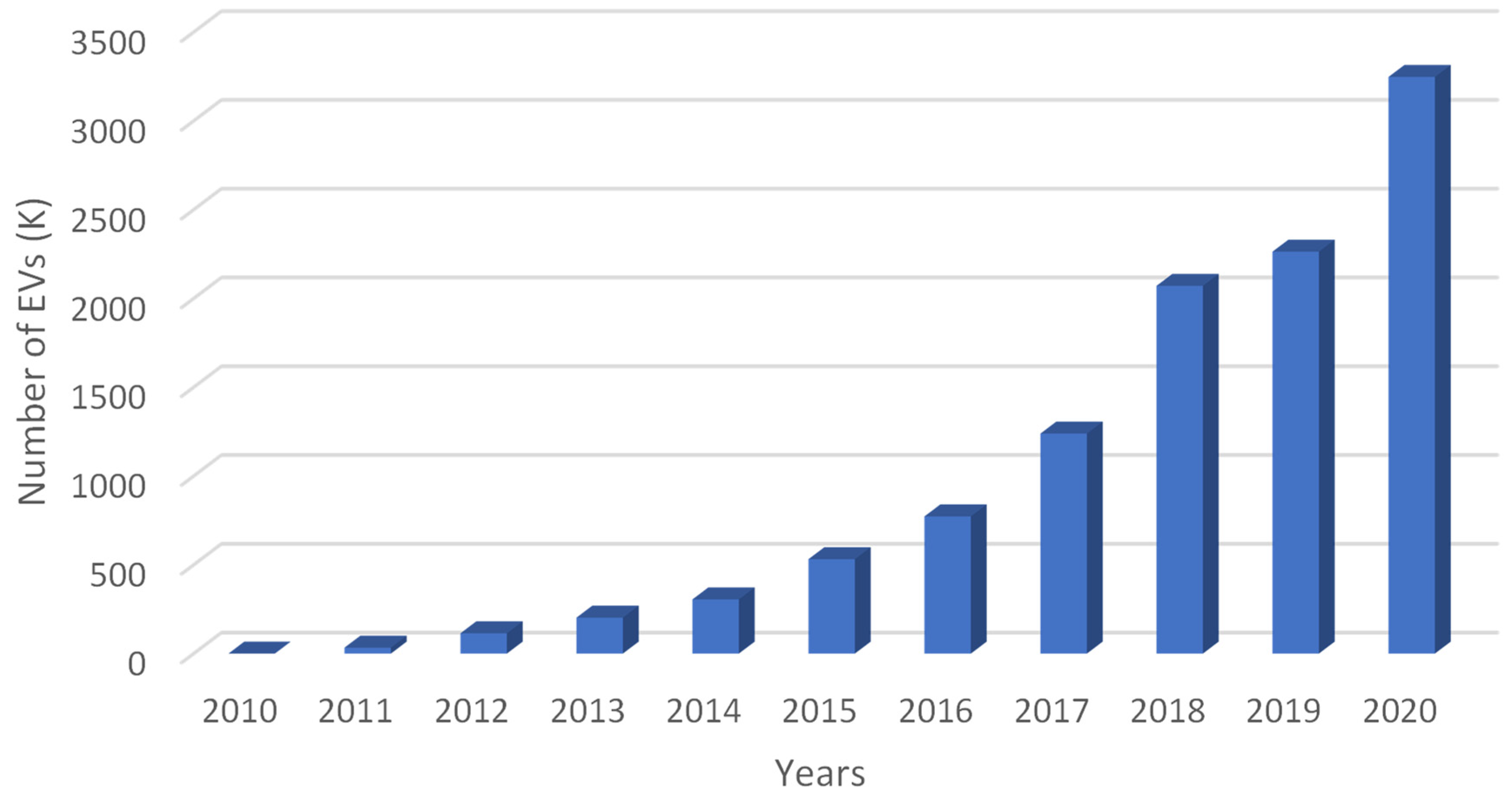
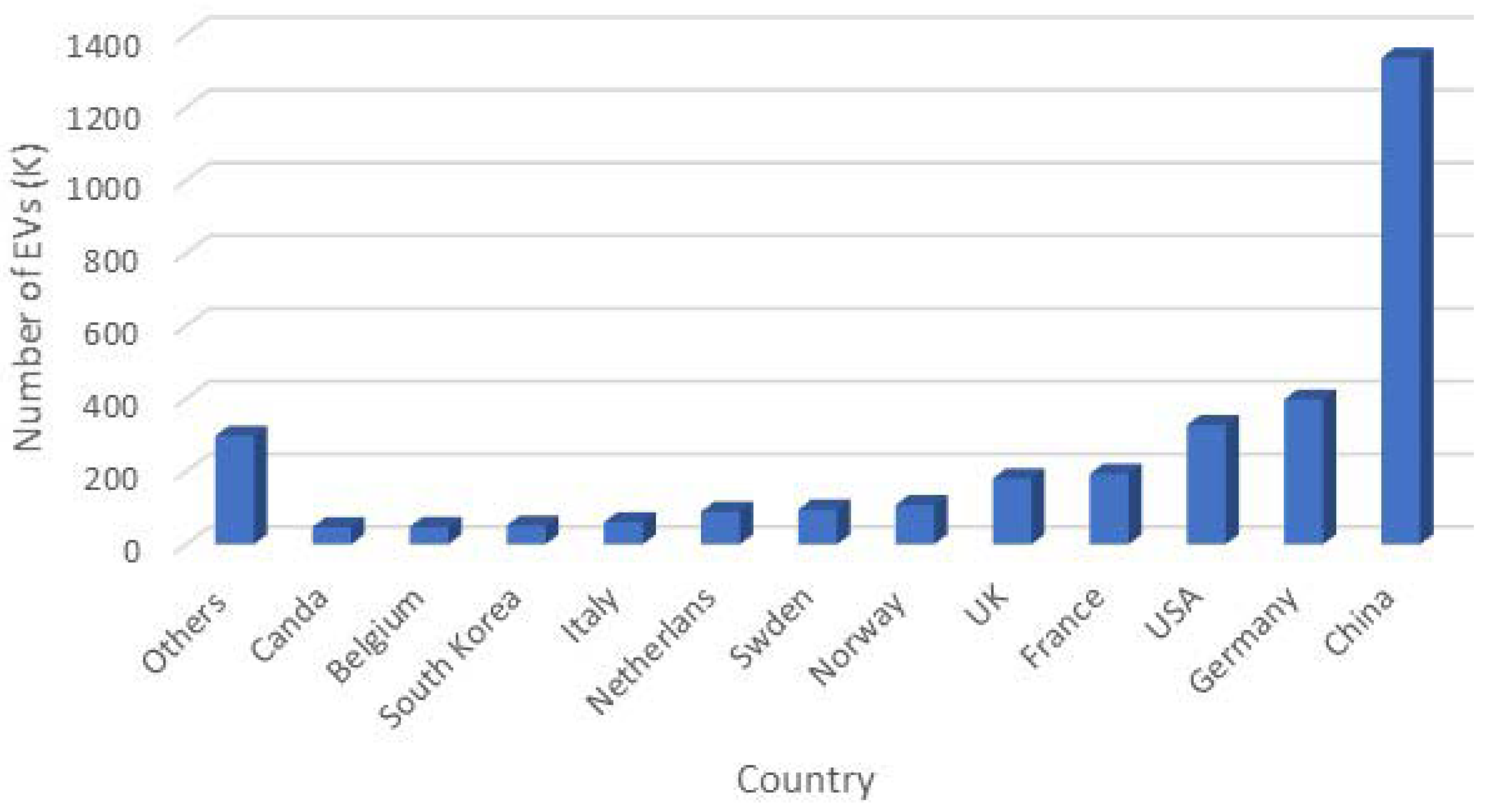
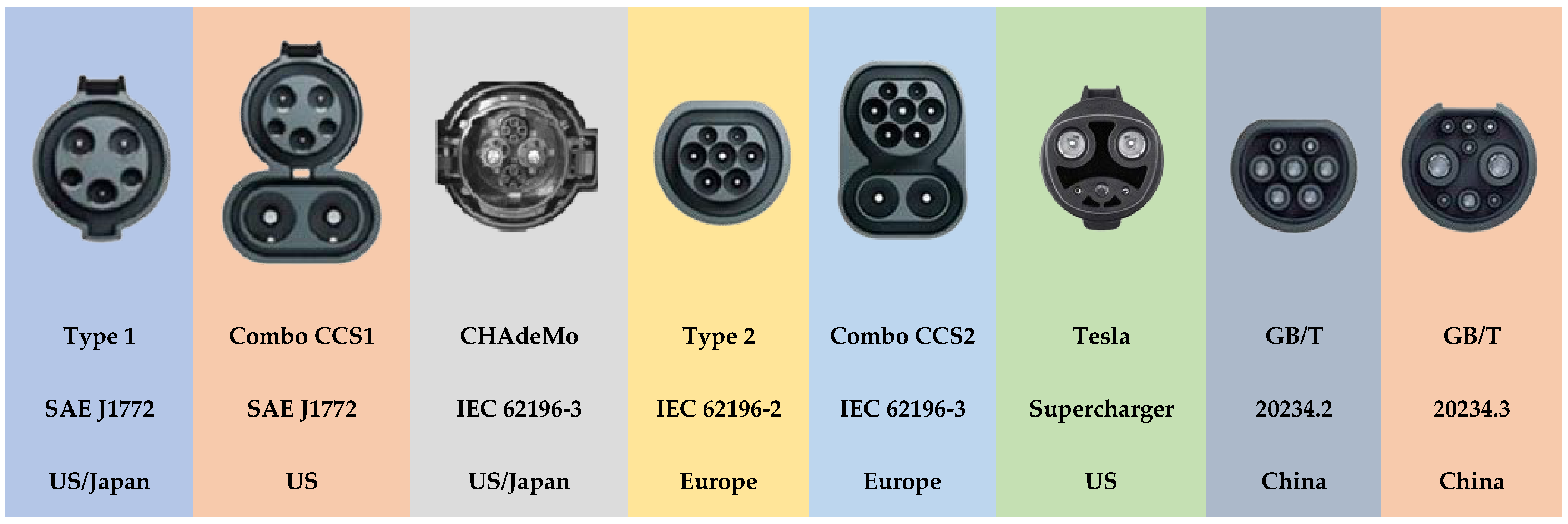
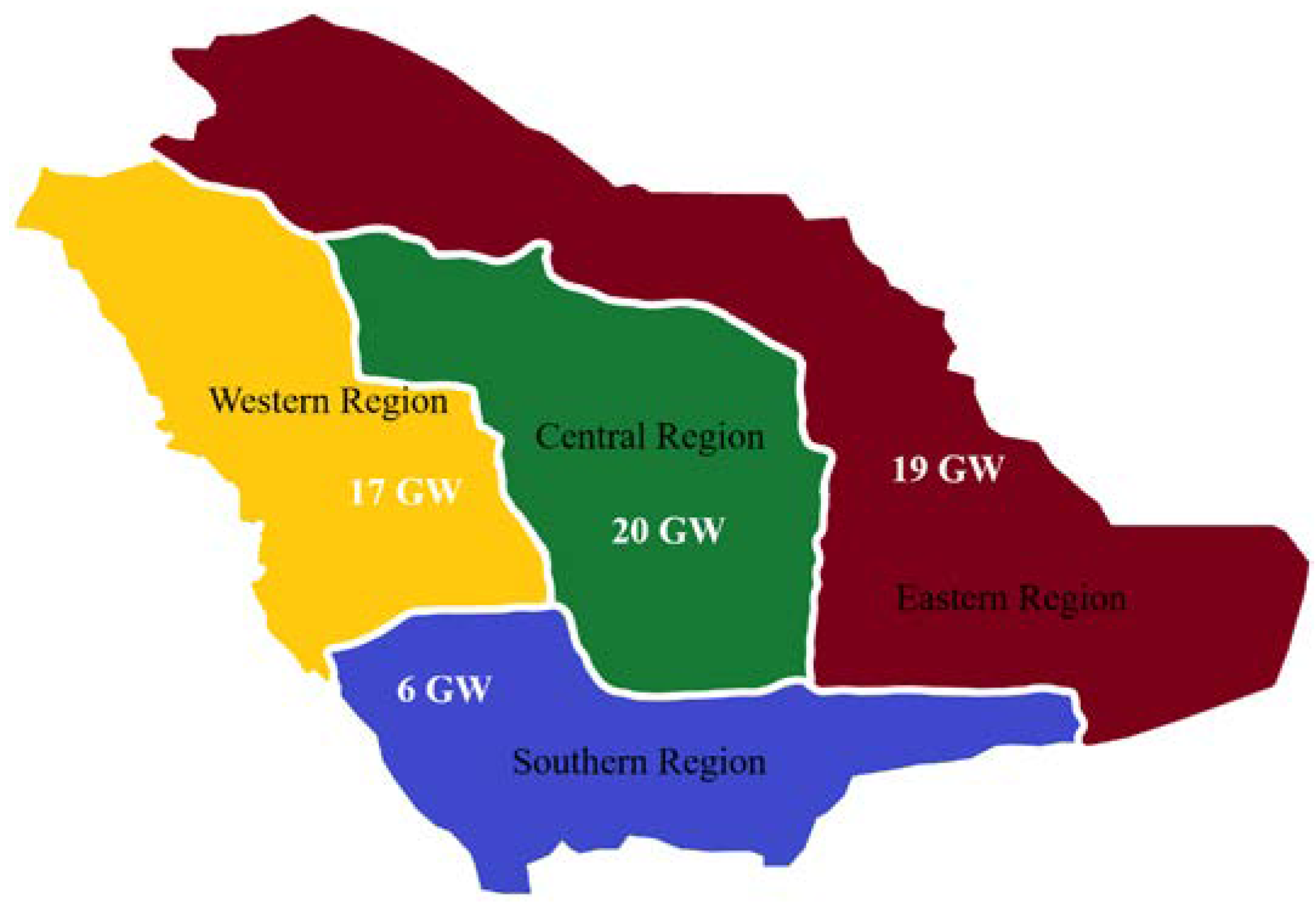
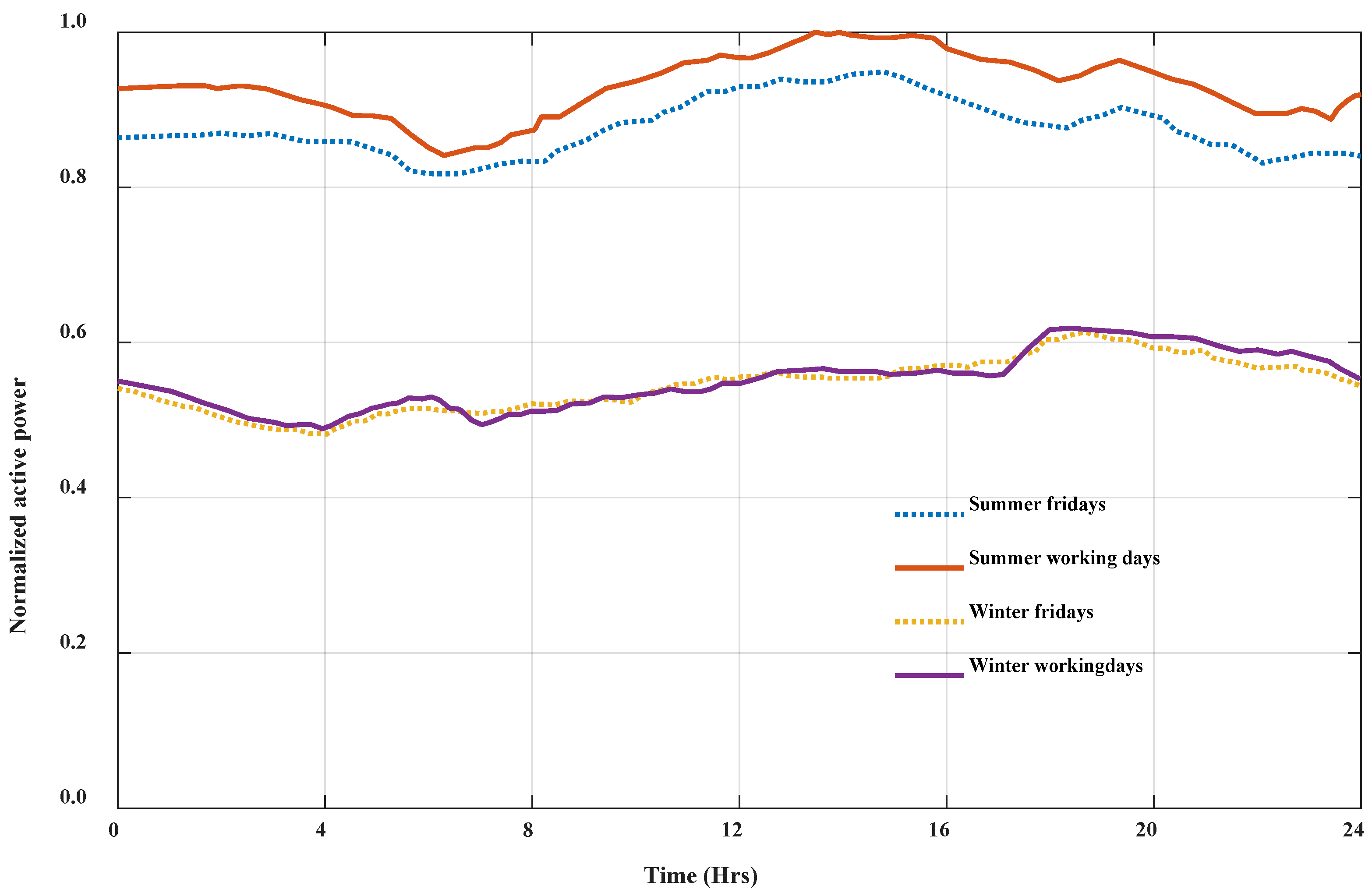
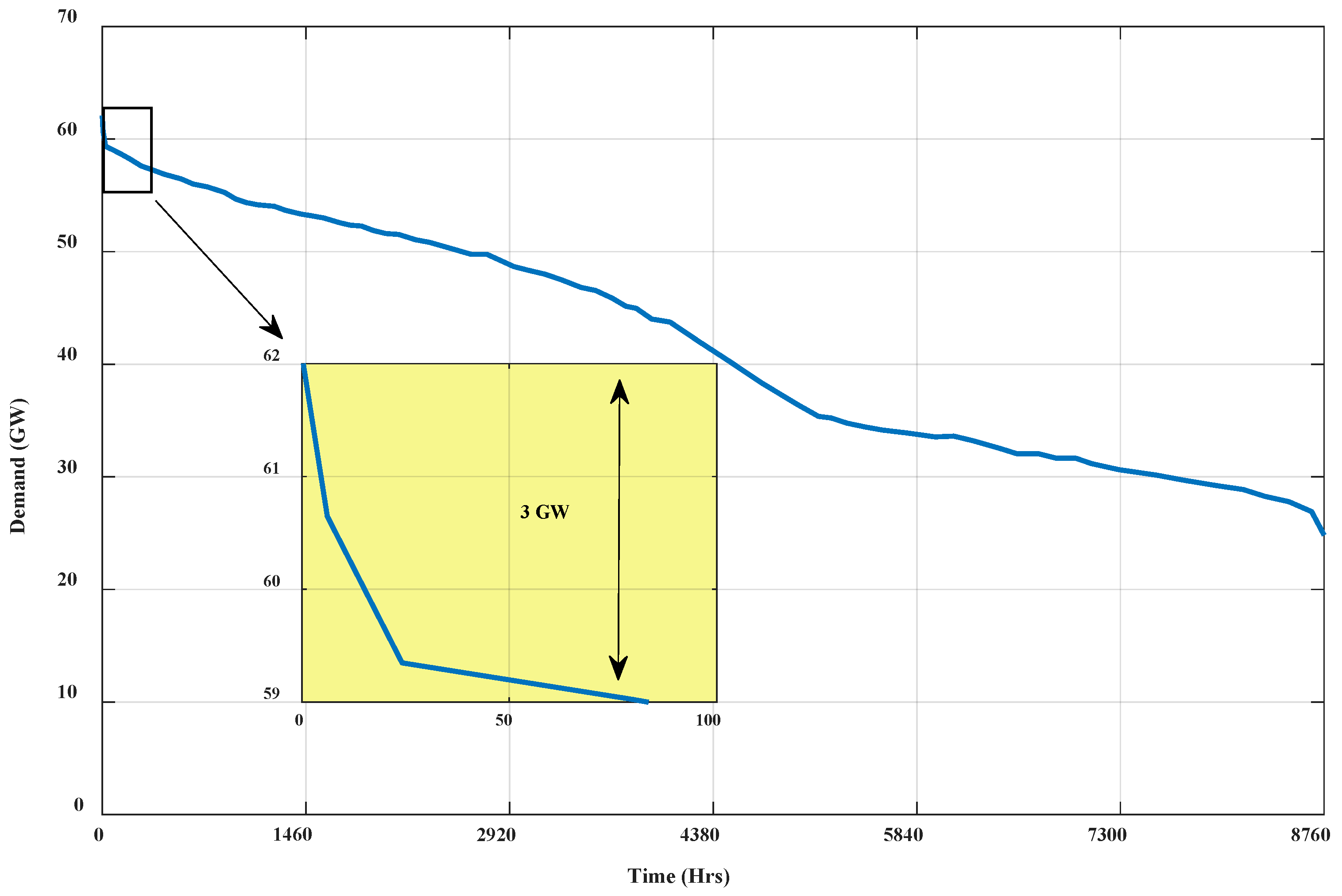
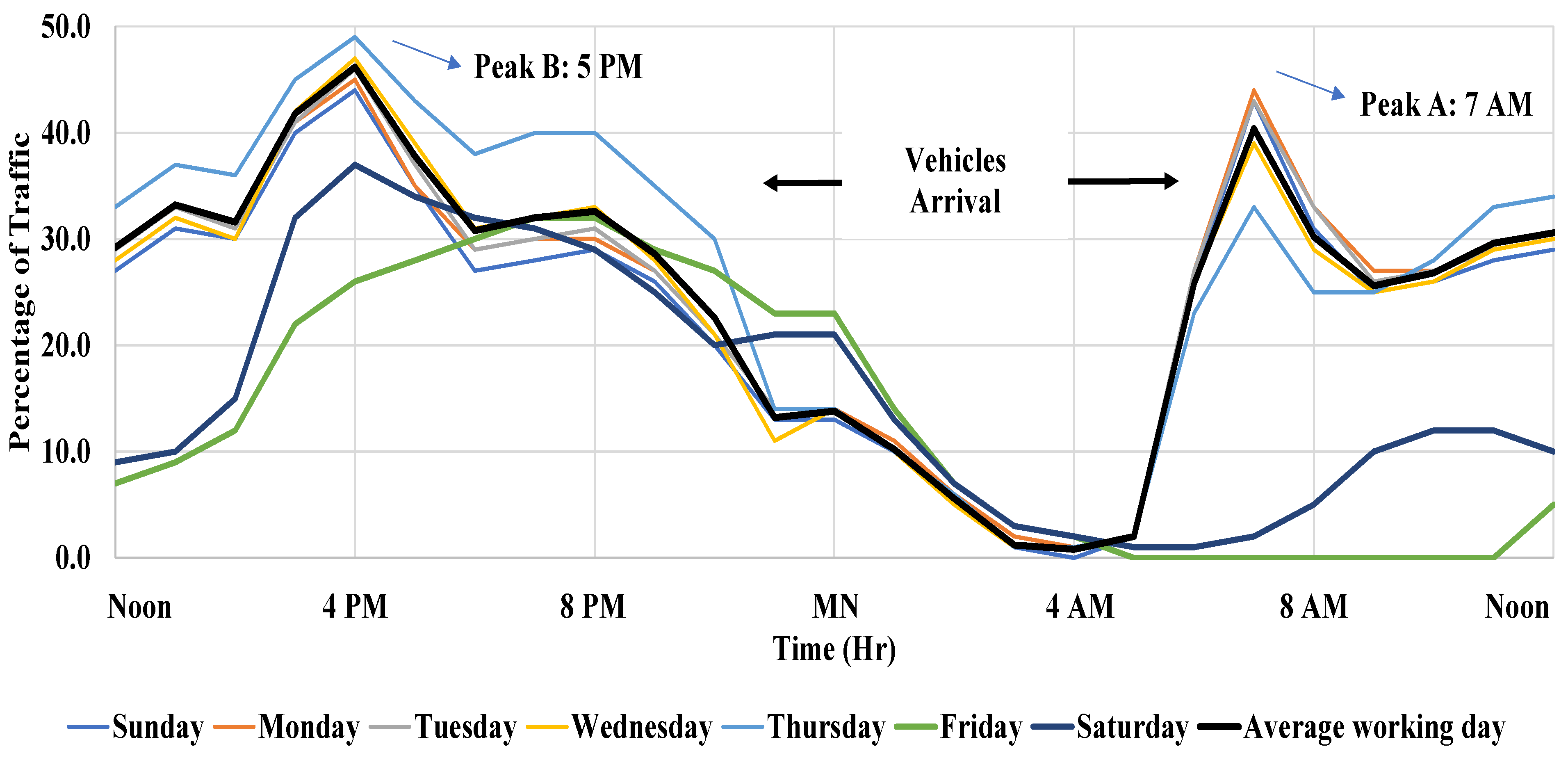
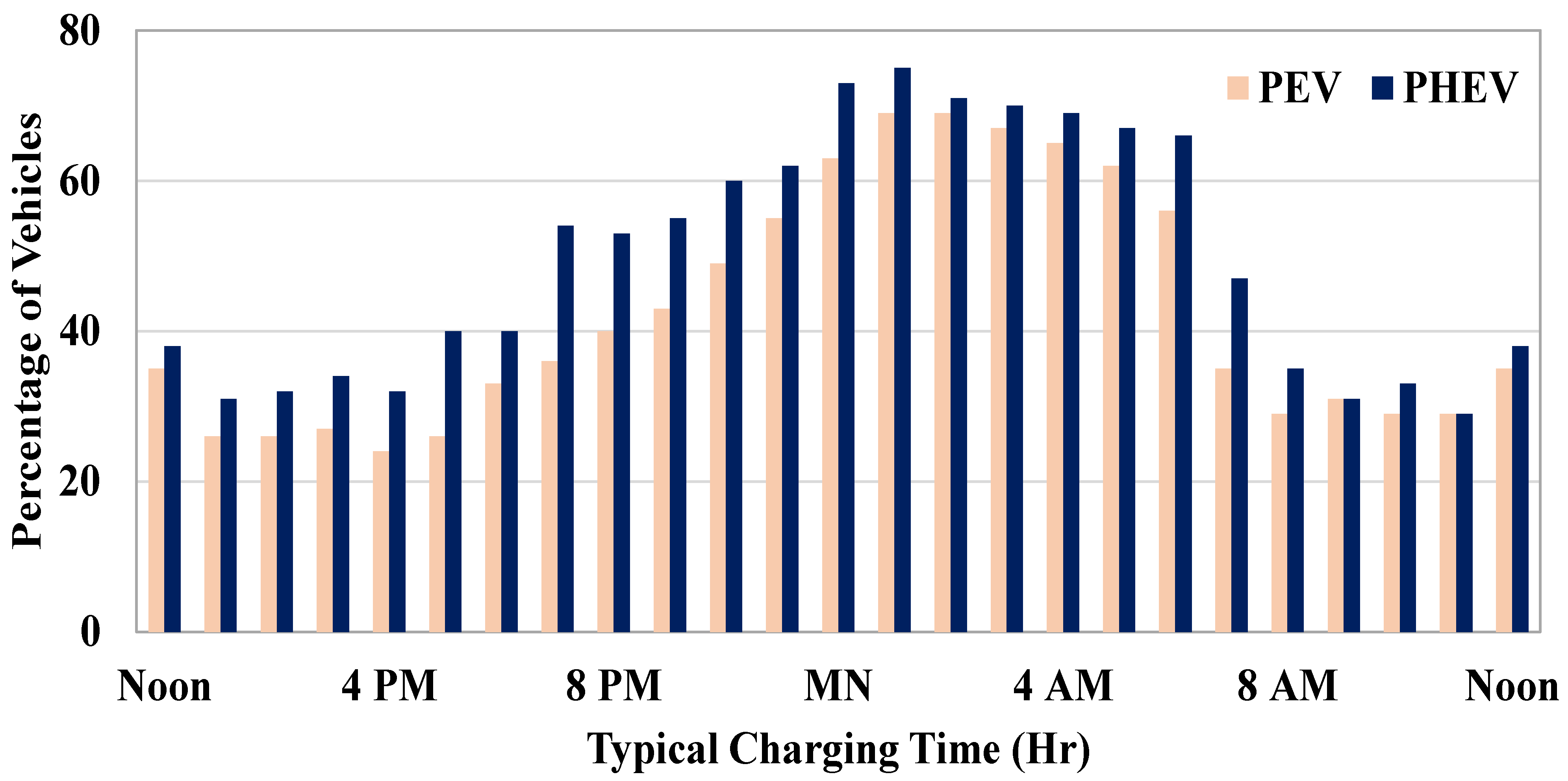
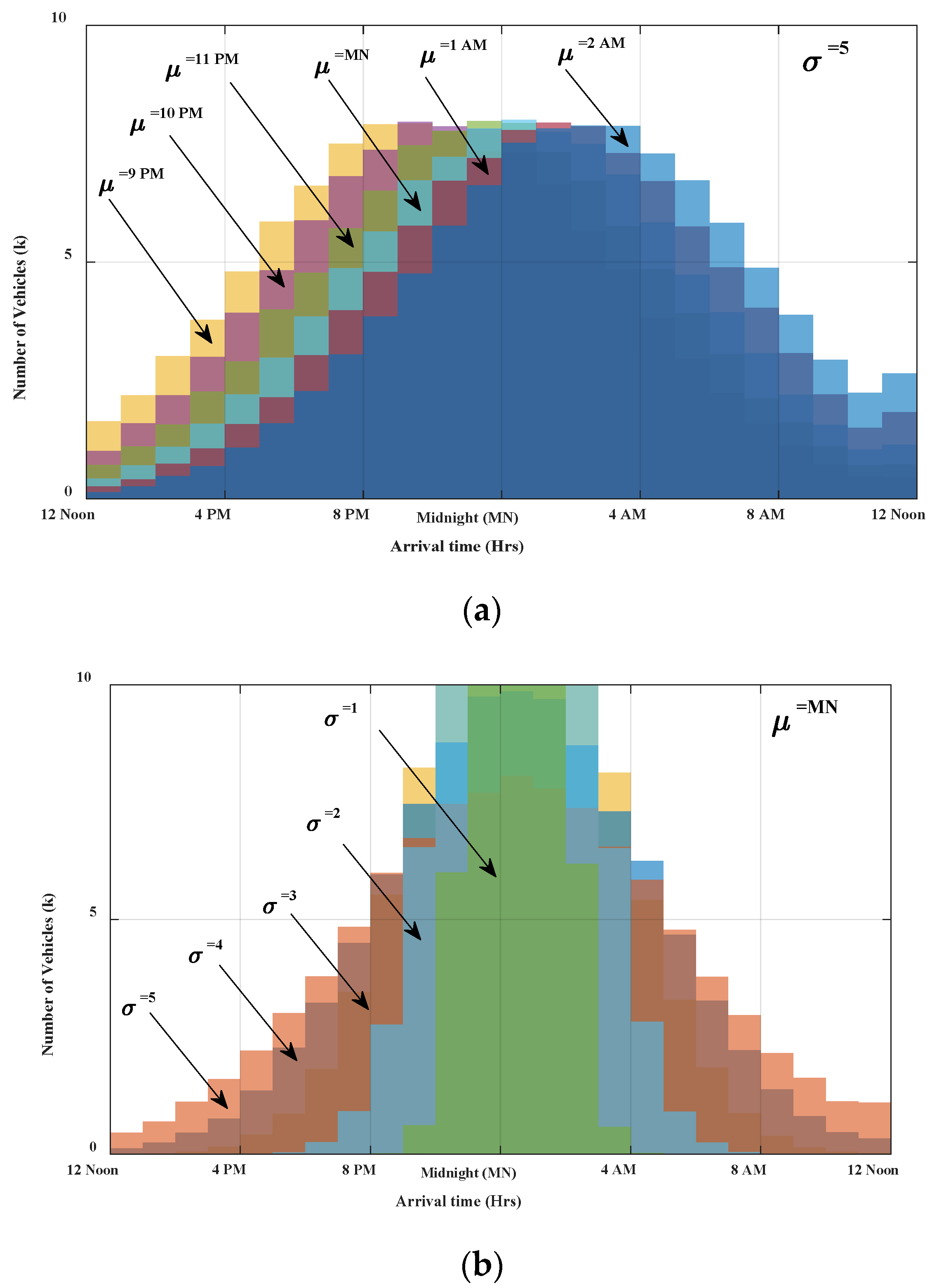
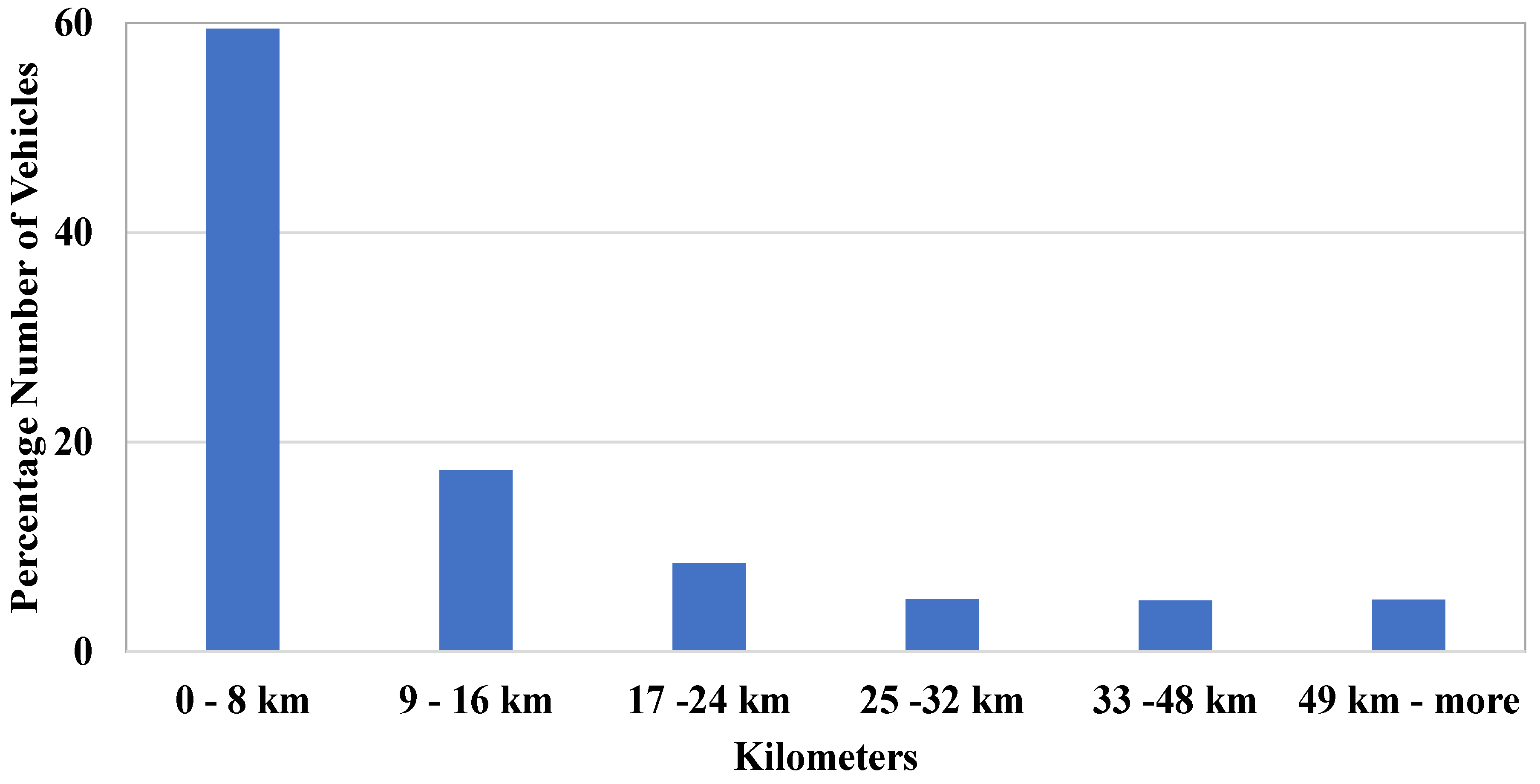
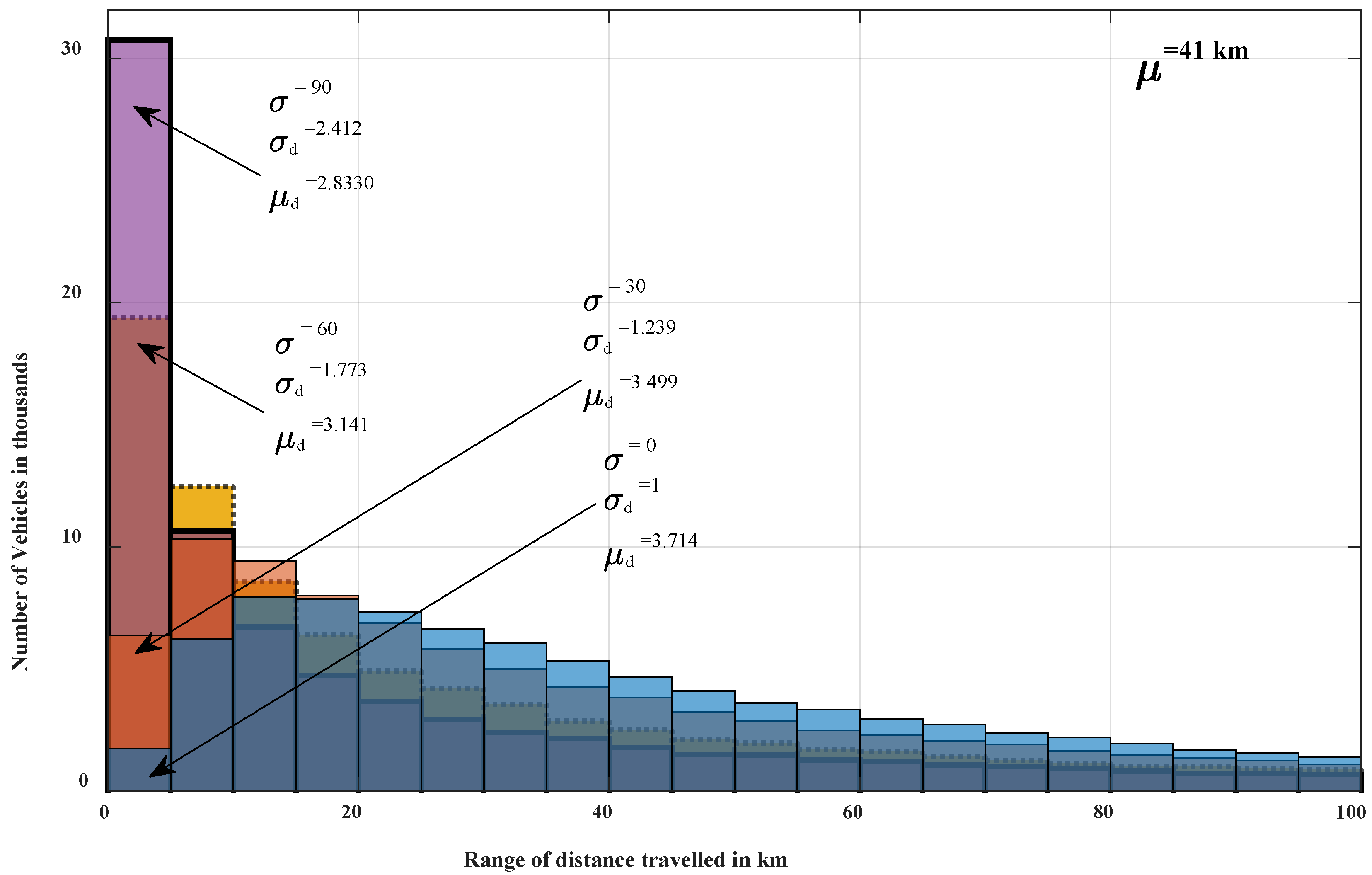
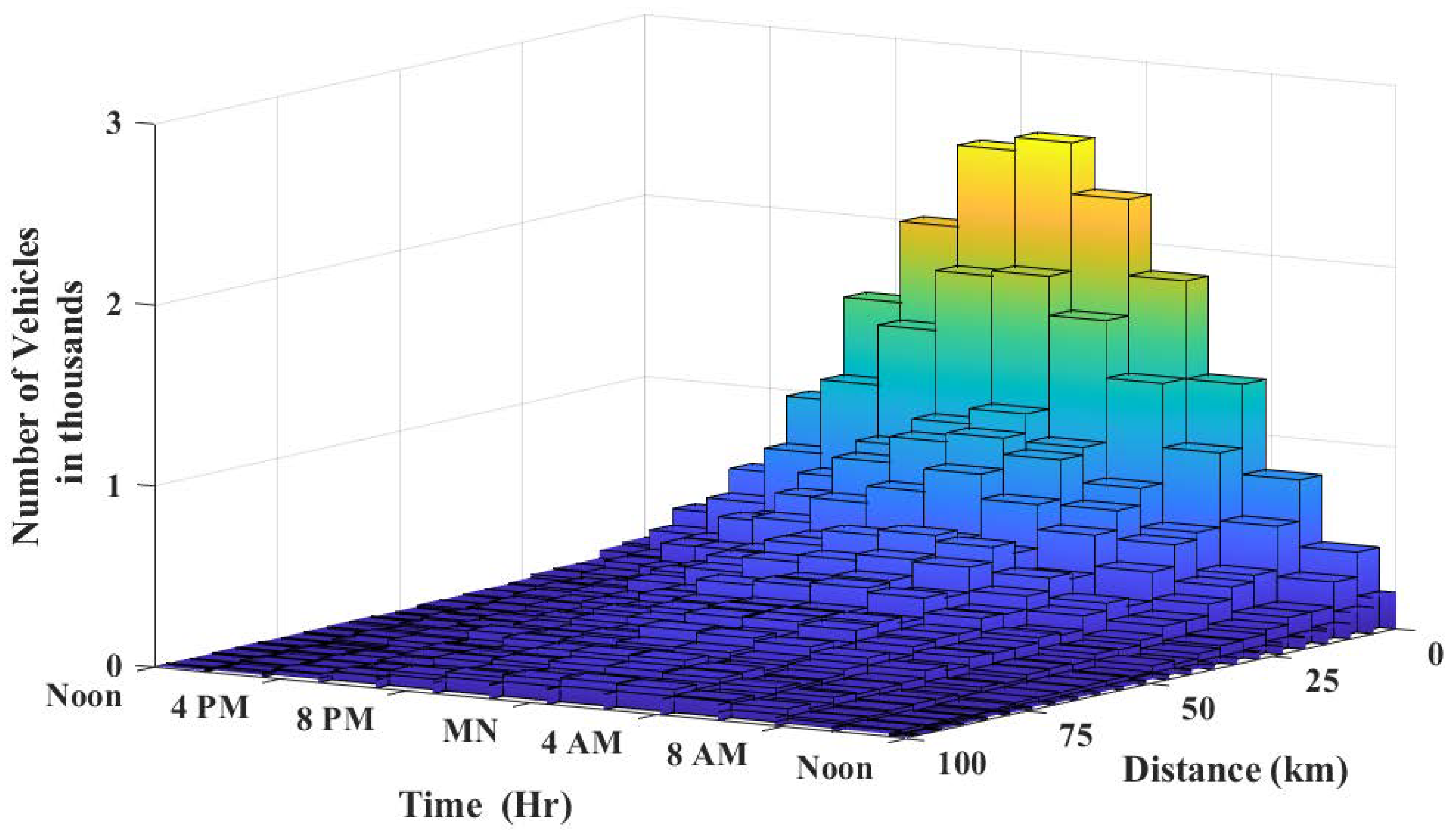
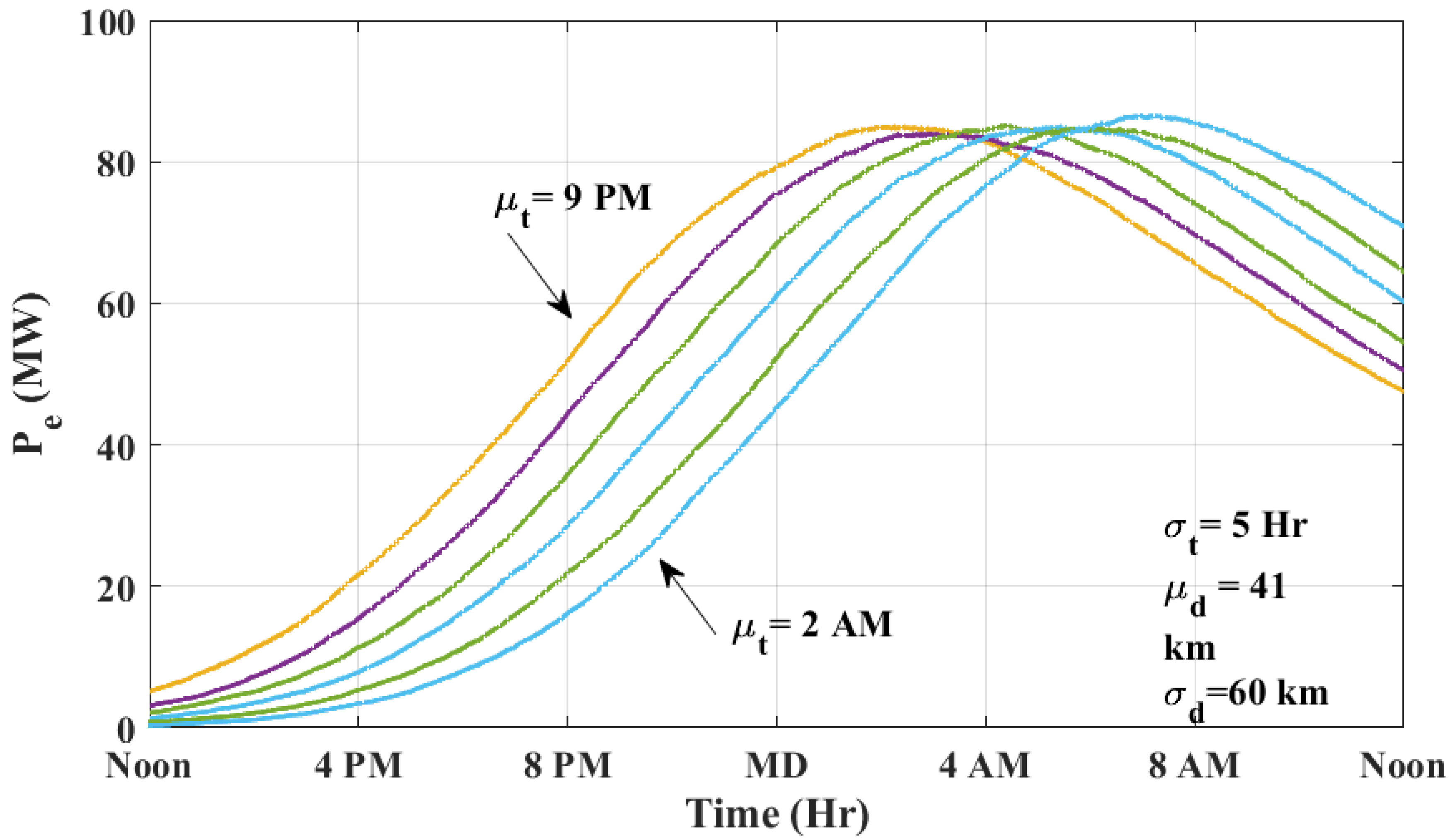
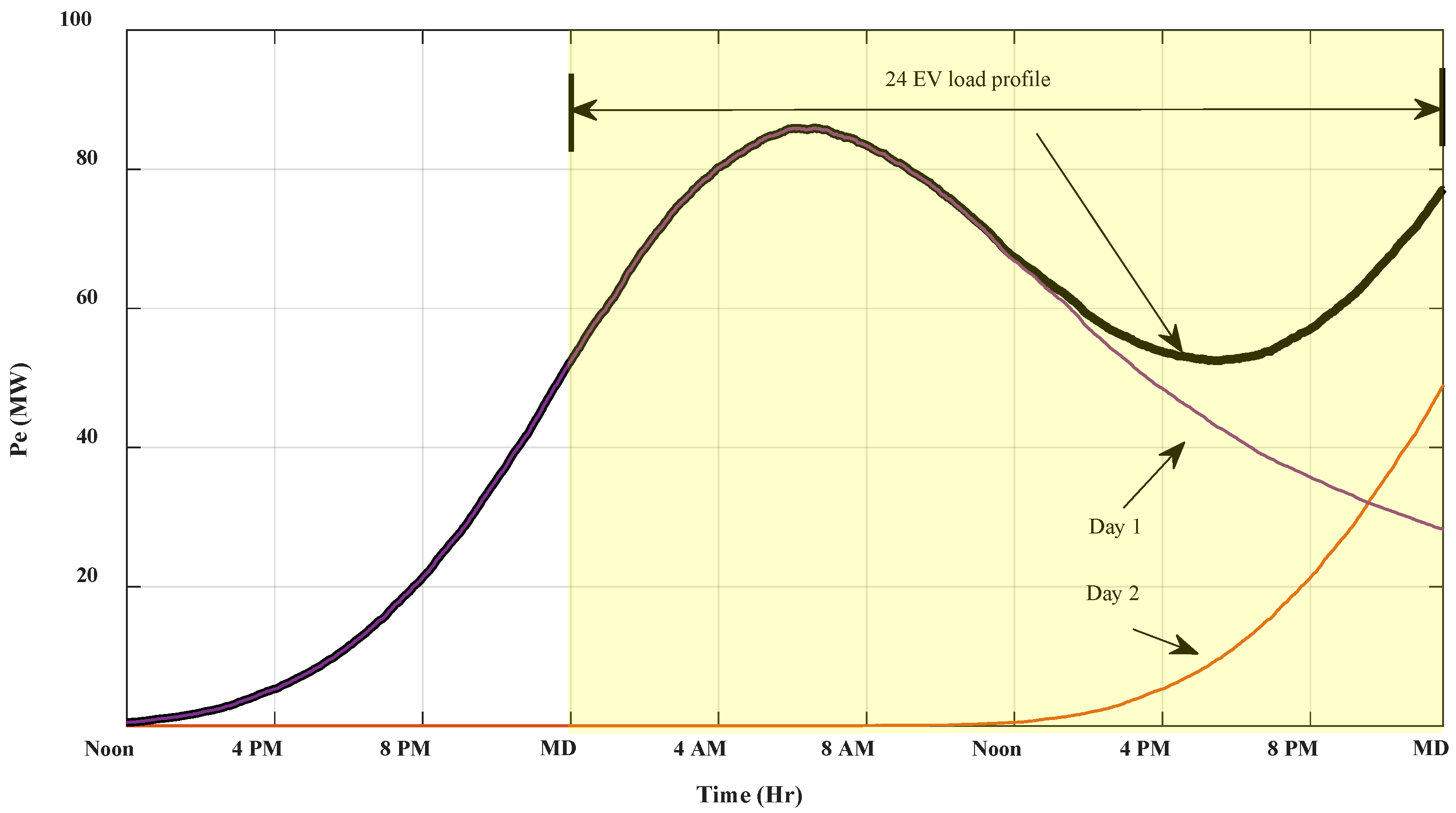
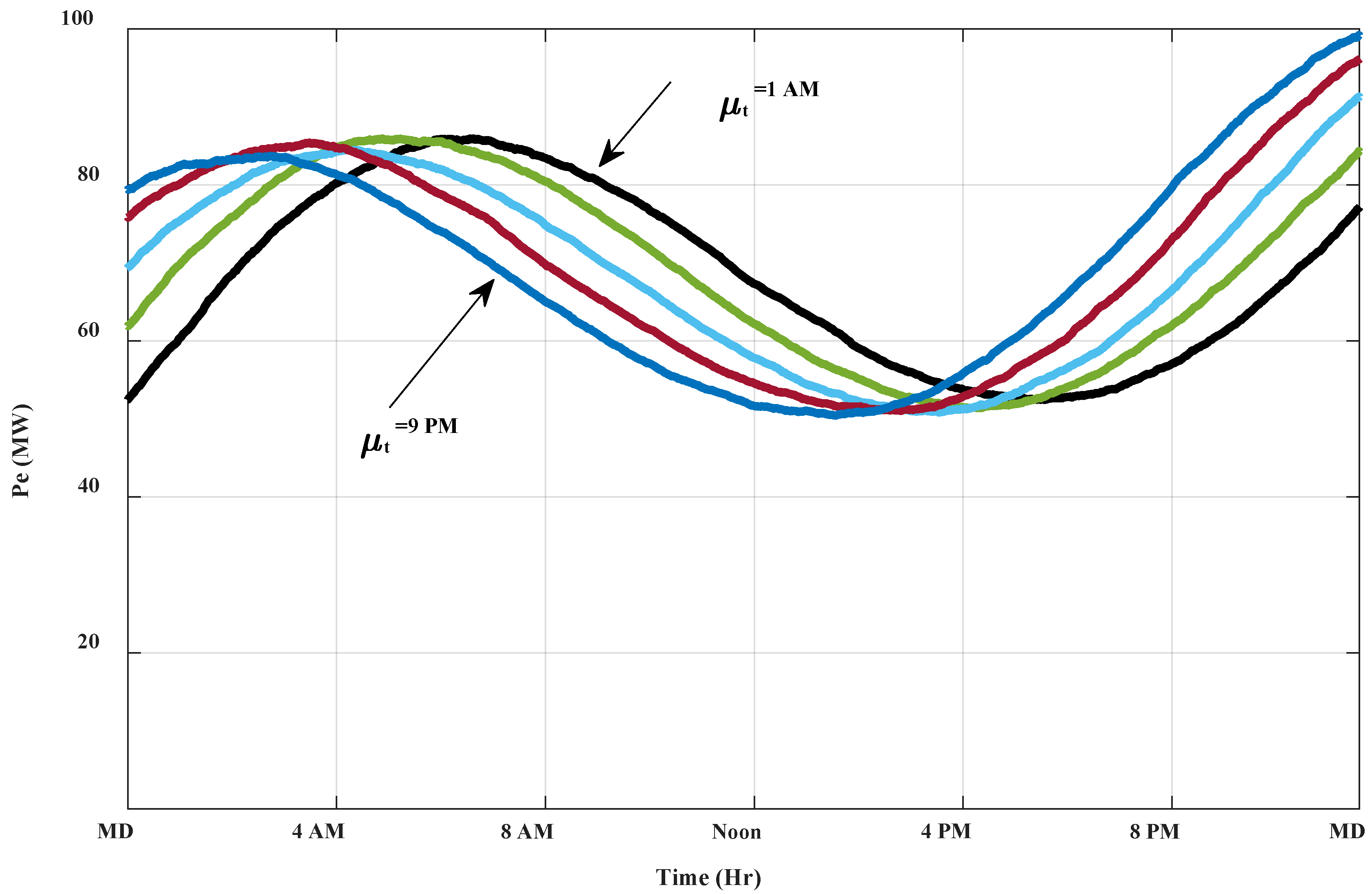
| Model | Drive | Type | Capacity (kWh) | Range (km) |
|---|---|---|---|---|
| 2021 Tesla Model S Long Range (AWD) 19″ | AWD | Tesla | 100 | 652 |
| 2021 Tesla Model S Plaid 19″ | AWD | Tesla | 100 | 628 |
| 2021 Tesla Model X Long Range (AWD) 20″ | AWD | Tesla | 100 | 579 |
| 2021 Tesla Model X Plaid 20″ | AWD | Tesla | 100 | 547 |
| 2021 Ford Mustang Mach-E Route 1 ER RWD | RWD | Ford | 98.8 | 491 |
| 2021 Ford Mustang Mach-E Premium ER RWD | RWD | Ford | 98.8 | 483 |
| 2021 Ford Mustang Mach-E Premium ER AWD | AWD | Ford | 98.8 | 434 |
| 2021 Ford Mustang Mach-E GT ER AWD | AWD | Ford | 98.8 | 402 |
| 2021 Ford Mustang Mach-E GT Perf. ER AWD | AWD | Ford | 98.8 | 378 |
| 2021 Audi e-tron | AWD | Audi | 95 | 357 |
| 2021 Audi e-tron Sportback | AWD | Audi | 95 | 351 |
| 2021 Porsche Taycan (93 kWh) | RWD | Porsche | 93.4 | 362 |
| 2021 Porsche Taycan 4S (93 kWh) | AWD | Porsche | 93.4 | 365 |
| 2021 Porsche Taycan Turbo (93 kWh) | AWD | Porsche | 93.4 | 341 |
| 2021 Porsche Taycan Turbo S (93 kWh) | AWD | Porsche | 93.4 | 323 |
| 2022 Jaguar I-PACE EV400 | AWD | Jaguar | 90 | 377 |
| 2021 Volkswagen ID.4 Pro | RWD | Volkswagen | 82 | 418 |
| 2021 Volkswagen ID.4 Pro S | RWD | Volkswagen | 82 | 402 |
| 2021 Tesla Model 3 Long Range AWD | AWD | Tesla | 80 | 568 |
| 2021 Tesla Model 3 Perf. LR AWD 20″ | AWD | Tesla | 80 | 507 |
| 2021 Tesla Model Y Long Range AWD 19″ | AWD | Tesla | 80 | 525 |
| 2021 Tesla Model Y Perf. LR AWD 21″ | AWD | Tesla | 80 | 488 |
| 2021 Porsche Taycan (79 kWh) | RWD | Porsche | 79.2 | 322 |
| 2021 Porsche Taycan 4S (79 kWh) | AWD | Porsche | 79.2 | 320 |
| 2021 Polestar 2 | AWD | Porsche | 78 | 375 |
| 2021 Volvo XC40 Recharge | AWD | Volvo | 78 | 335 |
| 2021 Ford Mustang Mach-E Select SR RWD | RWD | Ford | 75.7 | 370 |
| 2021 Ford Mustang Mach-E Select SR AWD | AWD | Ford | 75.7 | 339 |
| 2022 Chevrolet Bolt EV | FWD | Chevrolet | 65 | 417 |
| 2022 Chevrolet Bolt EUV | FWD | Chevrolet | 65 | 397 |
| 2021 Hyundai Kona Electric | FWD | Hyundai | 64 | 415 |
| 2021 Kia Niro EV (e-Niro) | FWD | Kia | 64 | 385 |
| 2021 Nissan LEAF e+ S (62 kWh) | FWD | Nissan | 62 | 364 |
| 2021 Nissan LEAF e+ SV/SL (62 kWh) | FWD | Nissan | 62 | 346 |
| 2021 Tesla Model 3 Standard Range Plus | RWD | Tesla | 60 | 423 |
| 2021 BMW i3 | RWD | BMW | 42.2 | 246 |
| 2021 BMW i3s | RWD | BMW | 42.2 | 246 |
| 2021 Nissan LEAF S (40 kWh) | FWD | Nissan | 40 | 240 |
| 2021 Hyundai IONIQ Electric | FWD | Hyundai | 38.3 | 274 |
| Type | Number | |||||
|---|---|---|---|---|---|---|
| 2015 | 2016 | 2017 | 2018 | 2019 | Total | |
| Buses | 24,431 | 11,839 | 10,502 | 8785 | 15,755 | 71,312 |
| Special Purpose Vehicles | 3433 | 2086 | 1110 | 941 | 1042 | 8612 |
| Passenger Cars and Jeeps | 839,239 | 618,382 | 475,722 | 422,185 | 539,993 | 2,895,521 |
| Type | Rapid Charging | Fast | Slow | |||
|---|---|---|---|---|---|---|
| Charging demand | 120 kW | 100 kW | 50 kW | 22 kW | 7 kW | 3 kW |
| Time (Hr) | 0.33 | 0.50 | 1.00 | 5.50 | 8.57 | 20.00 |
| Energy (kWhr) | 0–80% | 0–100% | ||||
Publisher’s Note: MDPI stays neutral with regard to jurisdictional claims in published maps and institutional affiliations. |
© 2022 by the author. Licensee MDPI, Basel, Switzerland. This article is an open access article distributed under the terms and conditions of the Creative Commons Attribution (CC BY) license (https://creativecommons.org/licenses/by/4.0/).
Share and Cite
Almohaimeed, S.A. Electric Vehicle Deployment and Integration in the Saudi Electric Power System. World Electr. Veh. J. 2022, 13, 84. https://doi.org/10.3390/wevj13050084
Almohaimeed SA. Electric Vehicle Deployment and Integration in the Saudi Electric Power System. World Electric Vehicle Journal. 2022; 13(5):84. https://doi.org/10.3390/wevj13050084
Chicago/Turabian StyleAlmohaimeed, Sulaiman A. 2022. "Electric Vehicle Deployment and Integration in the Saudi Electric Power System" World Electric Vehicle Journal 13, no. 5: 84. https://doi.org/10.3390/wevj13050084
APA StyleAlmohaimeed, S. A. (2022). Electric Vehicle Deployment and Integration in the Saudi Electric Power System. World Electric Vehicle Journal, 13(5), 84. https://doi.org/10.3390/wevj13050084





